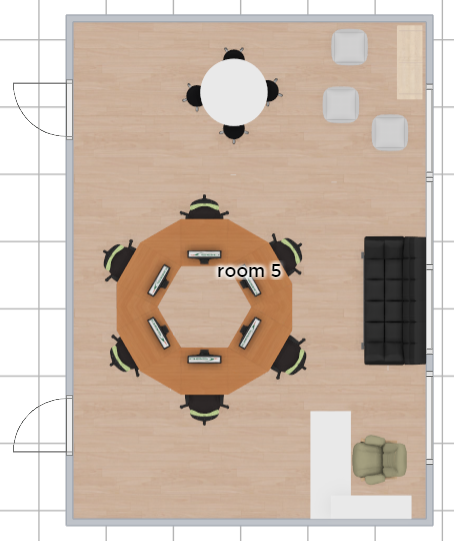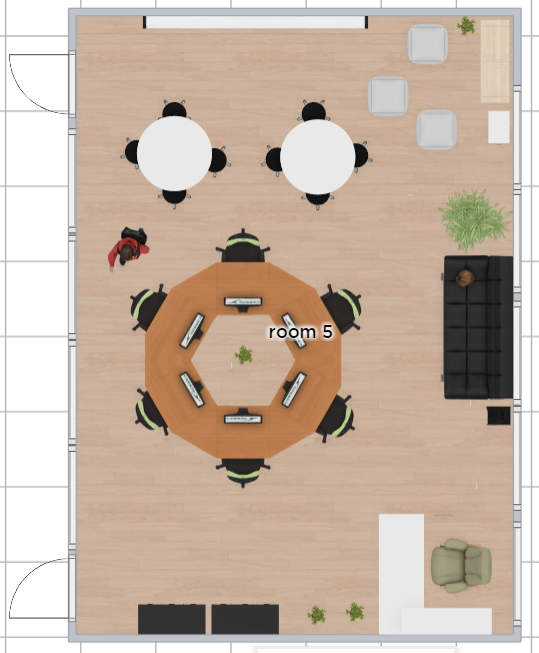Learning Space (Re)Design
- Shelby Hurst

- Apr 19, 2019
- 3 min read
In my graduate course, through Michigan State University, we are continually looking at innovation, learning, and technology with different lenses. This week, we took on the lens of design and how the design of a space can affect learning. I focused on how I can be more deliberate in the planning and decisions I make about connecting space, technology, and learning. Then, I created my own classroom space with these ideas in mind.
Before beginning my design, I first wanted to ask my high school students what their ideas would be. I posted this question on my Google Classroom page: if you could design your own classroom what would it look like? Most of the students asked for comfortable places to be able to a break, like a couch or a bean bag chair. Other suggestions were paint colors, air conditioning, refrigerators, windows, and padded seats. Engaging in a conversation with my students about their suggestions for the design was enlightening and fascinating. “West-Puckett (2014) describes how educators can design classrooms as makerspaces by focusing on student interest and by understanding learning as integrated and connected through projects rather than as an isolated set of skills” (Halverson & Sheridan, 2014). Their suggestions drove my inspiration and my creation for the design.

Using HomebyMe I created and designed my ideal classroom. The first decision I made was the seating. I wanted to incorporate multiple different learning spaces and also keep in mind my students’ ideas of comfort. I added two round tables with chairs that can swivel and move, bean bags, a couch and a circular table with computer chairs. As the book, The Third Teacher by O'Donnell Wicklund Pigozzi and Peterson, Bruce Mau, and David W. Orr, mentions “give students furniture that lets them twist and lean safely. The movement will increase their ability to concentrate” (2010). I want my students and me to have furniture that can be moved, which will create an easy transition into different learning activities. It is especially important to me to keep in mind my audience, which is a resource room filled with students of many different and unique abilities. A primary struggle for my students is maintaining focus. Having different areas with different types of furniture will encourage concentration.
Another aspect of the room design I incorporated was natural light and colors that promote warmth and calming. I chose a soft blue because I have students that are high energy and did not want a color that would cause over stimulation and create an overload of the senses. As mentioned in the article, The Inclusive Classroom: The Effects of Color on Learning and Behavior, blue has a “calming effect on heart rate and respiratory system” (2011). Natural light was another request by my students. They do not prefer the harsh lights that are often in many classrooms. The Third Teacher also states that “increasing daylight in classrooms has been shown to cut down on absenteeism and improve test scores” (OWP/P, 2010).
The research and information I have read this week has shown me how powerful experience design is. John Dewey, the author of Experience and Education, said, “if an experience arouses curiosity, strengthens initiative, and sets up desires and purposes that are sufficiently intense to carry a person over dead places in the future, continuity works in a very different way” (1997). He then goes on to say “every experience is a moving force”, which is why my design is based on what I intend my students to experience (1997). I intend for my students to feel that my classroom is a second home, a space filled with respect, expectations, and understanding that iteration is expected. I want my students to be able to strive for success within an environment that encourages that.
Resources:
Halverson, E. R., & Sheridan, K. (2014). The Maker Movement in Education. Harvard Educational Review,84(4), 495-504. doi:10.17763/haer.84.4.34j1g68140382063
OWP/P, Mau, B., & Orr, D. W. (2010). The Third Teacher: 79 Ways You Can Use Design to Transform Teaching & Learning.
Gaines, K. S. & Curry, Z. (2011). The Inclusive Classroom: The Effects of Color on Learning and Behavior, Journal of Family & Consumer Sciences Education, 29(1)
Dewey, J. (1997). Experience and education. New York: Touchstone.











Comments